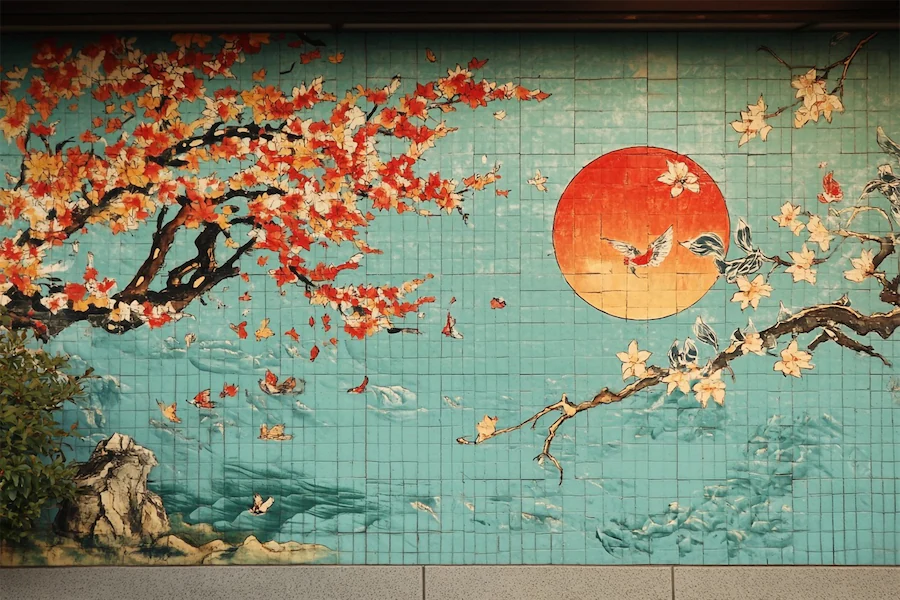Japanese wall designs are integral to the country’s architectural and interior design aesthetics, emphasizing simplicity, natural materials, and a harmonious connection with nature. These designs reflect traditional Japanese values and have been adapted over time to suit modern living spaces.
History and Origins of Japanese Wall Designs
Traditional Japanese interiors prioritize minimalism and functionality, with walls playing a crucial role in defining spaces. Historically, walls were constructed using natural materials like wood and paper, facilitating a connection with the surrounding environment. The use of sliding doors and screens allowed for flexible space utilization, adapting rooms for various purposes as needed.
Key Features of Japanese Wall Designs
Japanese wall designs are characterized by several distinctive features:
- Shoji Screens: These are sliding panels made of translucent paper framed in wood, allowing natural light to filter through while maintaining privacy. Shoji screens are fundamental in traditional Japanese homes, serving as doors, windows, and room dividers.
- Natural Materials: Walls often incorporate materials such as wood and bamboo, bringing warmth and texture to interiors. The use of natural elements fosters a serene and calming atmosphere, aligning with the Japanese aesthetic of simplicity and connection to nature.
- Minimalist Aesthetics: Emphasizing clean lines and uncluttered spaces, Japanese wall designs avoid excessive ornamentation, focusing instead on the beauty of simplicity and functionality. This minimalist approach creates a sense of tranquility and order within the space.
- Integration with Nature: Designs often feature elements that blur the boundaries between indoor and outdoor spaces, such as large windows or open-plan layouts, fostering a harmonious relationship with the natural environment. This integration is central to Japanese design philosophy, promoting a balanced and peaceful living experience.
Applications of Japanese Wall Designs
Japanese wall designs are applied in various contexts, including:
- Residential Interiors: Incorporating shoji screens and natural materials to create flexible, light-filled living spaces that can be adapted for different uses. This adaptability allows for efficient use of space, catering to various activities and enhancing the functionality of the home.
- Commercial Spaces: Utilizing minimalist wall designs to evoke a sense of calm and focus, often seen in restaurants, tea houses, and meditation centers. The simplicity and elegance of Japanese wall designs contribute to a welcoming and peaceful ambiance in commercial settings.
- Modern Adaptations: Integrating traditional elements with contemporary design to create a fusion known as Japandi, combining Japanese minimalism with Scandinavian functionality. This style emphasizes natural materials, neutral color palettes, and a focus on craftsmanship, resulting in spaces that are both aesthetically pleasing and highly functional.
Considerations When Choosing Japanese Wall Designs
When selecting Japanese wall designs, consider the following:
- Material Authenticity: Opt for natural and high-quality materials to maintain the integrity and longevity of the design. Using authentic materials not only enhances the aesthetic appeal but also aligns with the traditional principles of Japanese design.
- Space Functionality: Ensure that the design allows for flexibility and efficient use of space, adhering to the Japanese principle of multifunctional areas. Incorporating elements like sliding doors or movable partitions can facilitate this adaptability.
- Cultural Sensitivity: Respect the cultural significance of traditional designs, especially when incorporating elements like calligraphy or religious symbols. Understanding the meanings and contexts of these elements is crucial to creating a respectful and authentic design.
Conclusion
Japanese wall designs offer a timeless and serene aesthetic that emphasizes simplicity, natural materials, and harmony with nature. By integrating these elements thoughtfully, spaces can be transformed into tranquil environments that reflect the essence of Japanese design philosophy.
